Wine Tourism in Slavonia and Baranja: Interest Surpassing Capacities
November 17, 2022 - Although wine tourism in Croatia has excellent potential among domestic tourists, and it is a niche that generates great added value and links the development of other segments of the economy, this potential is poorly utilised.
As Poslovni writes, there are no wine hotels, museums, entertainment facilities, or wine roads. However, the interest of potential guests is high, according to an extensive survey conducted by the Improve agency with the consulting firm BlueRock (BRC) this September.
An excellent example of Austria
The research will also be used for the new Strategy for developing wine tourism in Slavonia and Baranja, which BlueRock is working on for the association Graševina Croatica, the largest association of winemakers in Slavonia and Baranja, confirmed Emanuel Tutek, a partner in BRC. "Wine tourism is one of the leading tourist products in Croatia, and at the same time, no Slavonian county has got any strategic document for the development of this product, although the wine business is one of the aggregates for the development of value-added tourism. At the same time, wine tourism is an important lever for the development of winemaking itself and agriculture, as shown by the example of Austria, which successfully connected these two segments, but not without large investments. Wine tourism and winemaking then promote the export component," said Tutek for Poslovni Dnevnik.
Until now, there was no qualitative data on the potential market, i.e., guests who are users or are interested in wine tourism. Of the total number of foreign guest arrivals in Croatia, it is not known precisely how many are wine tourists, that is, those whose primary motive for coming is wine and wine experiences.
There are only estimates for Istria, the leading tourist region with 21.7 million overnight stays in 2021, of which foreign guests make up 85 percent. Istria also has the most developed wine tourism.
It is estimated that wineries in Istria have around 290,000 visitors per year, among whom 30-35% are local, which means that the share of local visitors in Istrian wine tourism is twice that of their share in total arrivals.
BlueRock commissioned research that pointed to additional potential from the domestic guest segment. The study was conducted using an online survey, and respondents were recruited from the ImproveOnline panel.
The research showed 71 percent of respondents were not wine tourists in the last two years. On the other hand, 74 percent of respondents have an interest in wine tourism.
"Therefore, there is a significant market potential that has not yet been used; that is, there is a lack of supply. It is basic, and its development can address potent consumer segments. Visiting wineries is the most common form of wine tourism in Croatia, as are tours of the wine roads. Wine tourism activities, especially with greater added value, such as wine education and workshops, are popular among younger ages (25-34 years) and those with above-average incomes. At the same time, wine events and attractions are better attended in continental Croatia," the analysis states.
The survey also showed that 56% of wine tourists visited the regions of continental Croatia, which is influenced by the proximity of Zagreb. Tutek sees even greater significance in the hilly wine regions north of Zagreb and Slavonia, their current focus.
For the development of wine tourism, the tourist value chain is also necessary, which means that accessibility should be increased, and all necessary infrastructure should be provided, from accommodation, restaurants, museums, and interpretation centers to the development of destination management companies. Tutek notes that this is not the winemaker's job, although it most often boils down to that, as shown by the example of Plešivica near Zagreb.
For more, make sure to check out our dedicated Travel section.
Croatian Winemakers Won 254 Medals at the Decanter World Wine
July 10, 2021 - Croatian winemakers continue to win, receiving 254 medals at the 18th edition of the prestigious Decanter World Wine Awards, 28 more than last year.
The long-awaited results of the 18th edition of the Decanter World Wine Awards 2021 have been announced, Turističke priče reports. The world’s largest wine competition has had the biggest challenge to date, with a record 18,094 wines from 56 countries applying. For 15 consecutive days in June, nearly 170 wine judges, including 44 wine masters and 11 sommelier masters, declared the 50 best wines and 179 platinum, 635 gold, 5,607 silver, and 8,332 bronze medals.
Croatian winemakers won 254 medals at the Decanter World Wine Awards, 28 more than last year. Three Croatian wineries won the platinum medal and a total of 97 points - Benvenuti (Motova), Zure (Korčula), and Bire (Korčula). In total, Croatian winemakers won 3 platinum awards, 8 gold, as many as 80 wines were decorated with silver, and 163 bronze.
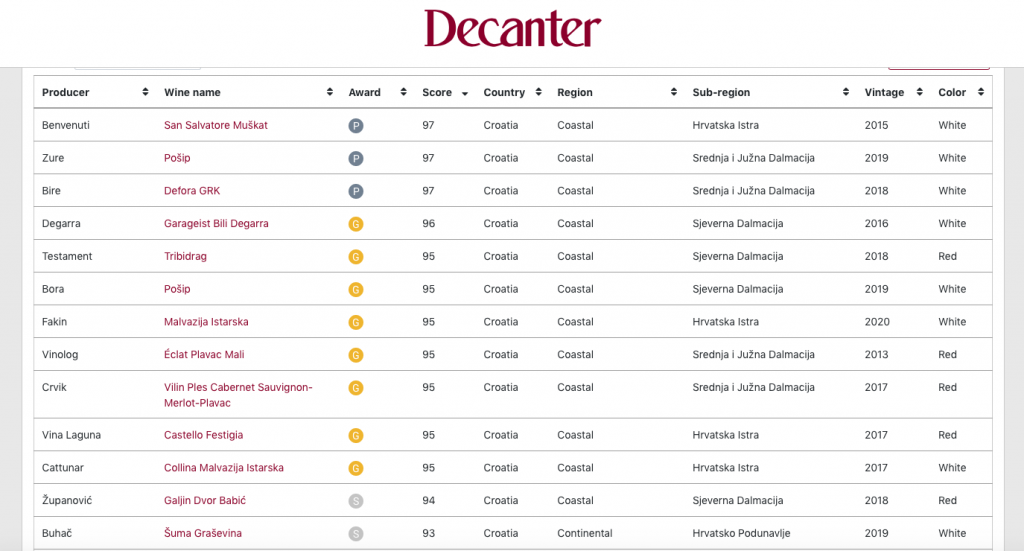
(Screenshot)
Unfortunately, this year we did not achieve positioning at the very top of Decanter's list with at least one wine in the category Best in Show or top 50 best wines in the world, but as more and more Croatian winemakers invest more and more in quality, we are sure that we will get to that last step.
Let's list the gold medals for eight wines: the coast was dominant, so five medals went to Dalmatia, and three to Istria.
Degarra Garageist Bili 2016.
Bora Posip 2019
Testament Tribidrag 2018.
Fakin Malvasia Istria 2020
Cattunar Collina Malvasia Istria 2017
Crvik Vilin Dance Cabernet Sauvignon-Merlot-Plavac 2017
Vinologist Eclat Plavac Mali 2013
Vina Laguna Castello 2017. - Festigia
You can see the full list of winners here.
Last year, Croatian wines won three platinum, 11 gold, 68 silver, 88 bronze awards, and 56 awards. At this year's Decanter, Spain dominated and more than doubled the medals compared to the year before when France was the main one. Nine of the 50 Best in Shows were awarded to Spanish wines, and out of the nine outstanding, as many as three offer exceptional quality for less than around 15 euros per bottle. It is important to mention Germany, which achieved record results, and especially worth mentioning Spätburgunder Pinot Noir and world-class chardonnay.
Croatian wines and grapes are among the best in the world, and you can find more information about them in Total Croatia’s Guide to Croatian Wine HERE. Now in your language!
For more made in Croatia news, follow TCN's dedicated page.
8th Pink Day Festival Announced For June 27th With the Best of Rosé Wines!
June 14, 2021 - A press conference was held announcing the 8th Pink Day and its interesting program. In addition to socializing with winemakers and olive growers, this favorite wine event will be marked by an entertainment program, so visitors and exhibitors can expect various surprises and even more beautiful and modern space.
This year, the 8th Pink Day International Festival of Rose Wines, Sparkling Wines, and Champagnes is being held for the first time on the covered open terrace of the MSU Museum in New Zagreb, on Sunday, June 27. Although the location and date of the event have been changed several times due to epidemiological reasons and the consequences of the Zagreb earthquake, the festival successfully brings together numerous domestic and foreign producers of rosé wines, about fifty of them, with about 100 labels of rosé wines. Winemakers, oenologists, professionals, experts, and rosé lovers will take part, and there is, of course, an important part of the Festival: Green in Pink, with a dozen of the best Croatian producers of extra virgin olive oil.

From Pink Day Official Facebook Page
At the press conference, WOW President and Pink Day founder Sanja Muzaferija, accompanied by art director Vlasta Pirnat, hostess Ana Lisak and MSU representatives, and in the presence of the co-organizer, IMC presented the novelties of the 8th Pink Day. Although the Festival always offers three or more wine and olive oil workshops, now for the first time, in cooperation with the Miva Wine Gallery, a Masterclass - World of Pink Champagnes by Moët Hennessy Group powered by Premium Visa has been organized, which has aroused great interest and sold out. just a few days. Visitors can expect two more workshops: Pink Austria, powered by Austrian Wine and with the help of the Office of the Federal Ministry of Agriculture, Regions, and Tourism at the Embassy of the Republic of Austria dedicated to Austrian rosés, and a workshop of extra virgin olive oils, Istria: Queen of Olive Oil powered by Catering Lisak, led by the famous Istrian expert Edi Družetić, who last year celebrated 40 years of work in olive growing.

Sanja Muzaferija, Pink Day founder
‘‘I am extremely proud that this year our partner country is Austria and that, despite still somewhat problematic conditions, five exhibitors are coming from Austria, all under the auspices of Austrian Wine, but I am most looking forward to the exhibition venues of this year's Pink Day filled three weeks before the Festival. It is also important to me that we try, and I believe we succeed, to combine everything: to entertain, teach, cheer and celebrate rosé wines in a rosy mood. And let’s not forget the health and extra virgin olive oils. I thank the media that follow us faithfully and everyone who experiences Pink Day the way I imagined it: as a festival of optimism and enjoyment’’, said Muzaferija.
The ticket price for Pink Day is 150 kuna, while for members of the WOW association it is 50 kuna, and you can buy it at the entrance of the festival.
This year, Pink Day emphasizes the sale of wine, since last year was also extremely difficult for winemakers, and each winemaker will receive ten pink bags as a gift from the festival to sell their wine. Also, Pink Day continues to reward the most imaginative and creatively decorated exhibition table. Last year's prize, pink Jimmy Choo shoes, was won by the Italian winery Bottega, and this time as many as 4 prizes will be awarded. It will again be pink Jimmy Choo shoes: this time a Smokey model worth a thousand dollars, a work of art "DESIDERIO N° 1 ART MUST BE TASTED" by Austrian artist Andrew Stix, made especially for Pink Day, as well as Privee cosmetics Nikel, Croatian innovator Mirjana Brlečić, but also the ingenious bottle cap Coravin, worth 300 euros.
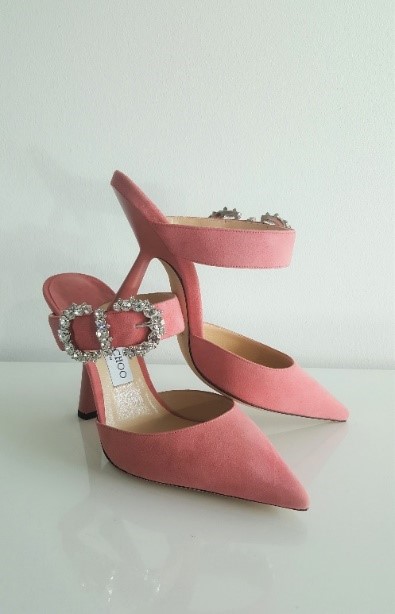
Pink Jimmy Choo shoes, last year's festival prize
Additionally, the current offer of all Croatian rosés will be judged by an independent jury composed of the most experienced Croatian wine judges. It is a mini-project "Drink Pink" conceived as part of the iVino concept, whose founders are journalists Ana Rogač and Ivo Kozarčanin. The best rosé wines of their choice and judgment decided, logically, to present and announce the winners, right on Pink Day.
As part of the press conference, Kutjevo held a presentation of the limited label Premium rosé, designed by the art director of Pink Day, Vlasta Pirnat, and the famous winemaker from Plešivica, Krešimir Ivančić, presented his Provencal-style rosé, Griffin Ambassador rosé. and Istrian olive oils were also tasted.
All of the above and much more interesting content await you at the 8th Pink Day, June 27, 2021, at the Zagreb Museum of Contemporary Art, MSU. All visitors will receive pink glasses as a gift until stocks run out so that after a long pandemic period they can try to look at the world more brightly and optimistically.
To learn more about the 8th Pink Festival, be sure to follow their Facebook and Instagram official accounts to find more information.
Croatian wines and grapes are among the best in the world, and you can find more information about them in Total Croatia’s Guide to Croatian Wine HERE.
For more on lifestyle in Croatia, follow TCN's dedicated page.
First Istria Wine and Walk Successfully Held Since Start of Pandemic
June 8, 2021 - After a year in which several events had to be canceled or postponed due to the pandemic, the first Istria Wine and Walk made a successful comeback marked by sold-out tickets and 450 participants who enjoyed the best of what Istrian wine and grapes can offer.
Tasting top wines and food, a relaxed atmosphere, and hours of enjoying the beauties of northwestern Istria marked the spring Wine & Walk, reports Turističke Priče. It has been shown that everyone is eager for such events after various restrictions and bans due to the coronavirus pandemic. This is supported by the fact that the tickets were sold out in less than 24 hours.
This is not surprising as this was the first Istria Wine and Walk since the pandemic was declared. The event was ideal, as it was possible to ensure compliance with all epidemiological measures.
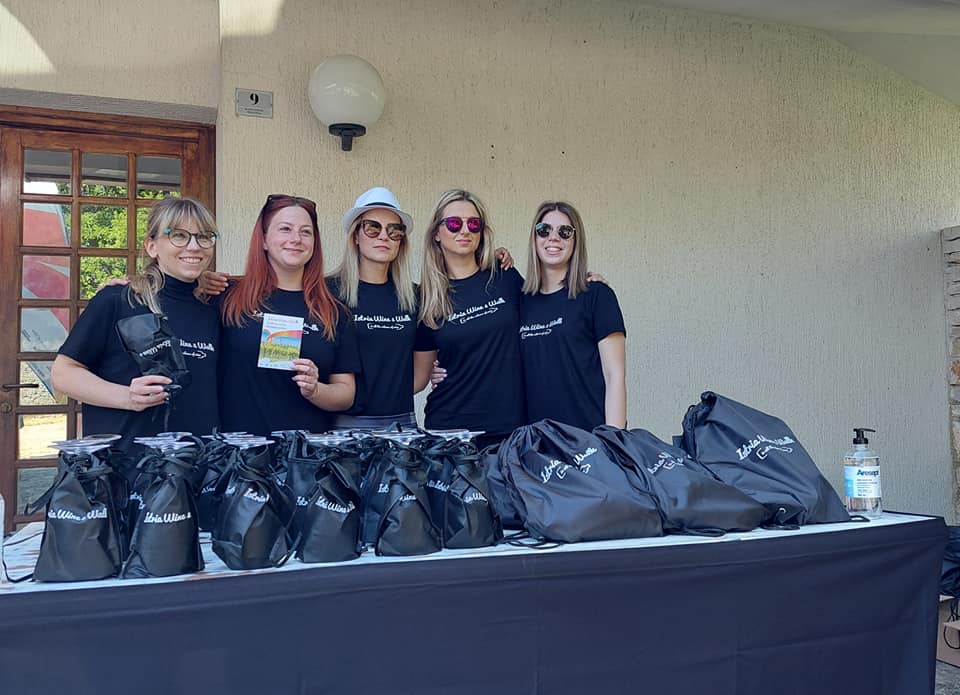
Photo: Istria Wine and Walk
The inspiring walk was attended by 450 participants who were divided into groups accompanied by a guide. The starter kit of the event, which included a tasting glass and a folder, this year's first Istria Wine and Walk event was "conveniently" enriched with a protective mask.
The walk started from the Aleksandar Rukavina Gallery in Brtonigla, and every kilometer and a half the participants were greeted by a new wine & food station with an offer of local Istrian producers and caterers. The offer included wines Benčić, Novacco, Coronica, Cattunar, Cuj, Veralda. The gourmet offer includes Circolo Bar, OPG Radošević, All event, Primizia Food & Wine, Konoba Morgan, OPG Buršić, Veralda. The length of the walk was nine kilometers, and the winemakers, in addition to offering their wines, introduced the participants to viticultural practices and oenological techniques in the production of their wines.
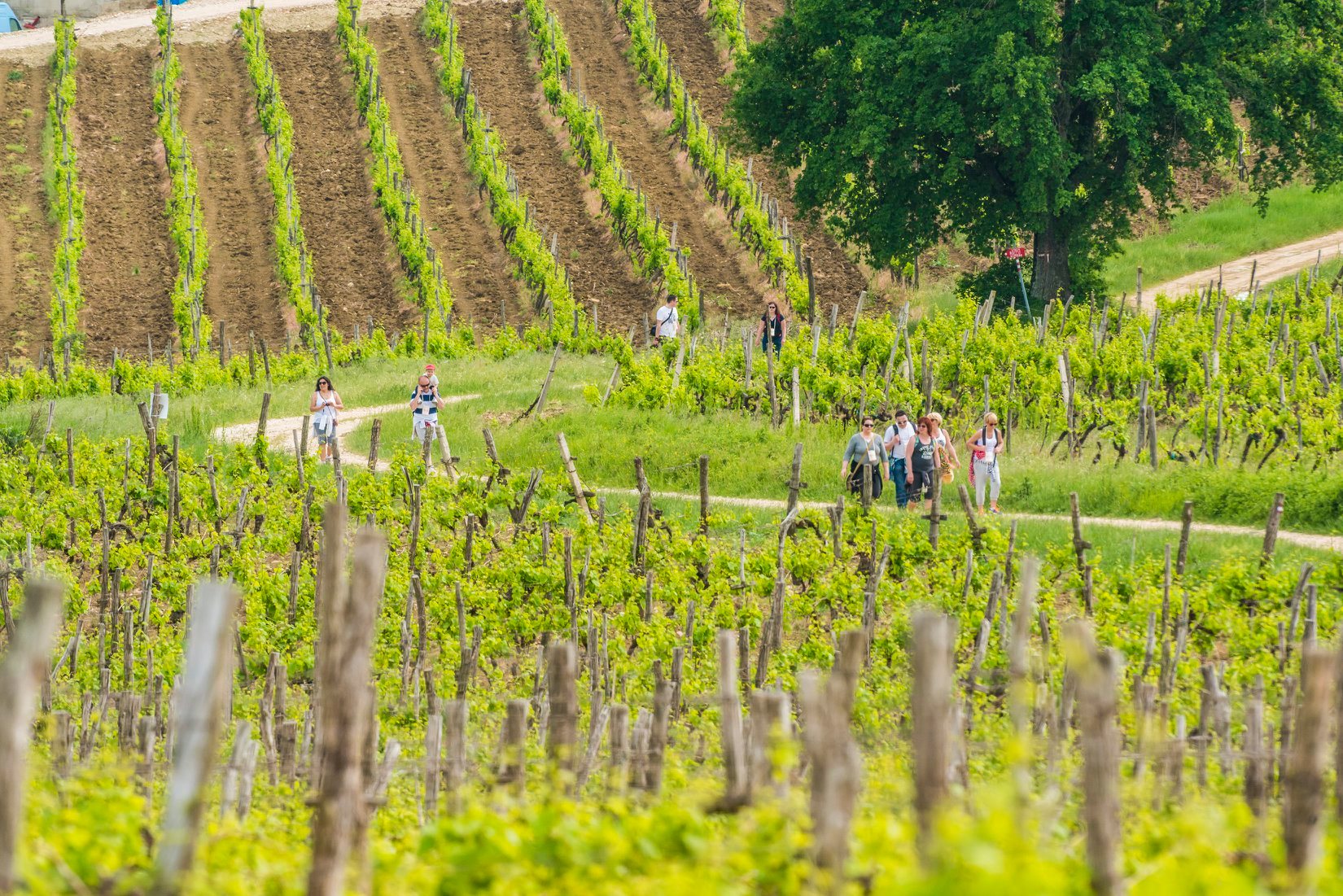
Photo: Istria Wine and Walk
Hikers and wine lovers enjoyed a panoramic view of Brtonigla and the sea from Monte Marzari, visited the cheese factory and farm Radošević from where they had a panoramic view of another Istrian pearl - Buje, the walk stretched to the Nature Park Škarline, wine cellar Cattunar, Tavern Morgan, and the Veralda wine cellar. Once again, intoxicated by the sun and a beautiful day, the walkers returned to the center of Brtonigla where they enjoyed the magic of this Istrian town.

Photo: Istria Wine and Walk
Istrian wines and grapes are among the best in the world, and you can find more information about them in Total Croatia’s Guide to Croatian Wine HERE. You can also learn more about what the Istrian peninsula cities and towns like Pula, Rovinj, Umag, Motovun, and more can offer you on your next trip, in Total Croatia HERE. Total Croatia’s articles are now available in your language!
For more on travel in Croatia, follow TCN's dedicated page.
Plešivica Sparkling Wines Served With Breakfast at Special Event
June 6, 2021 - Guests enjoyed a pleasant encounter with the best selection of Plešivica sparkling wines and breakfast snacks, in the hills outside Zagreb.
A sparkling breakfast in the Chez Suzy vineyard for the weekend was the real formula for outdoor hedonism, reports Turističke Priče. At Plešivica, Šember wineries, Šoškić court wines, Drago Damir Režek, and a guest from the Krašić vineyards, Šimanović winery, presented their sparkling wines for which this wine region is famous. In addition to Plešivica sparkling wines, guests enjoyed strawberries and indigenous products of Zagreb County and copanjek, and homemade game salami. As an announcement of the upcoming Sparkling Zagorje breakfast in Zagorje, štruklji, zlevanka, cheeses, chocolate mousses, and chocolate cake were also served.
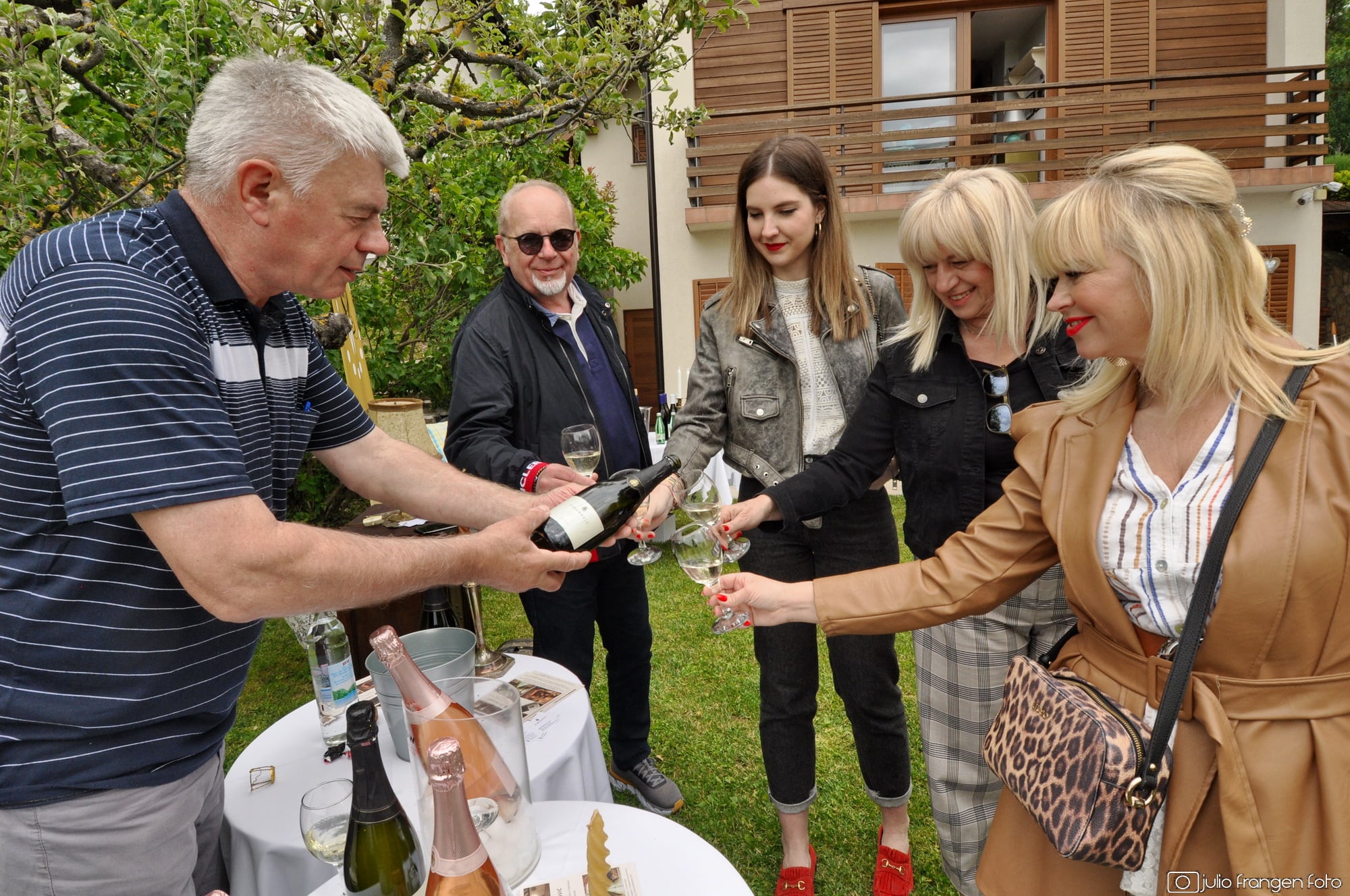
Salon of Sparkling Wines
The novelty of this year's Sparkling Breakfast edition was the guided pairing of food and Plešivica sparkling wines. The event was driven by the idea of the hostess Suzana Košćak, gastronomy students Izabela Andrašić, Adrian Karačić, Filip Poštenik, Bruno, Karić cooked at the event. The menus were paired with champagnes, after a hearty breakfast dominated by cheeses and strawberries, continued with freshly baked homemade focaccia and steak tartare that future chefs prepared next to the guests. It was a real "cooking show", and then from a small three delicious risottos came out in hot kitchens full of original ideas, the first with apple and celery, the second with asparagus, the third with strawberries. An additional joy of pairing was homemade macarons with champagne. Demanding but purposefully selected, the yellow lemon cream cookies were paired with white brut champagnes, and the pink champagnes matched the pink strawberry sour cream cookies. Macarons were made by a gastronomy student, Ana Tokić.
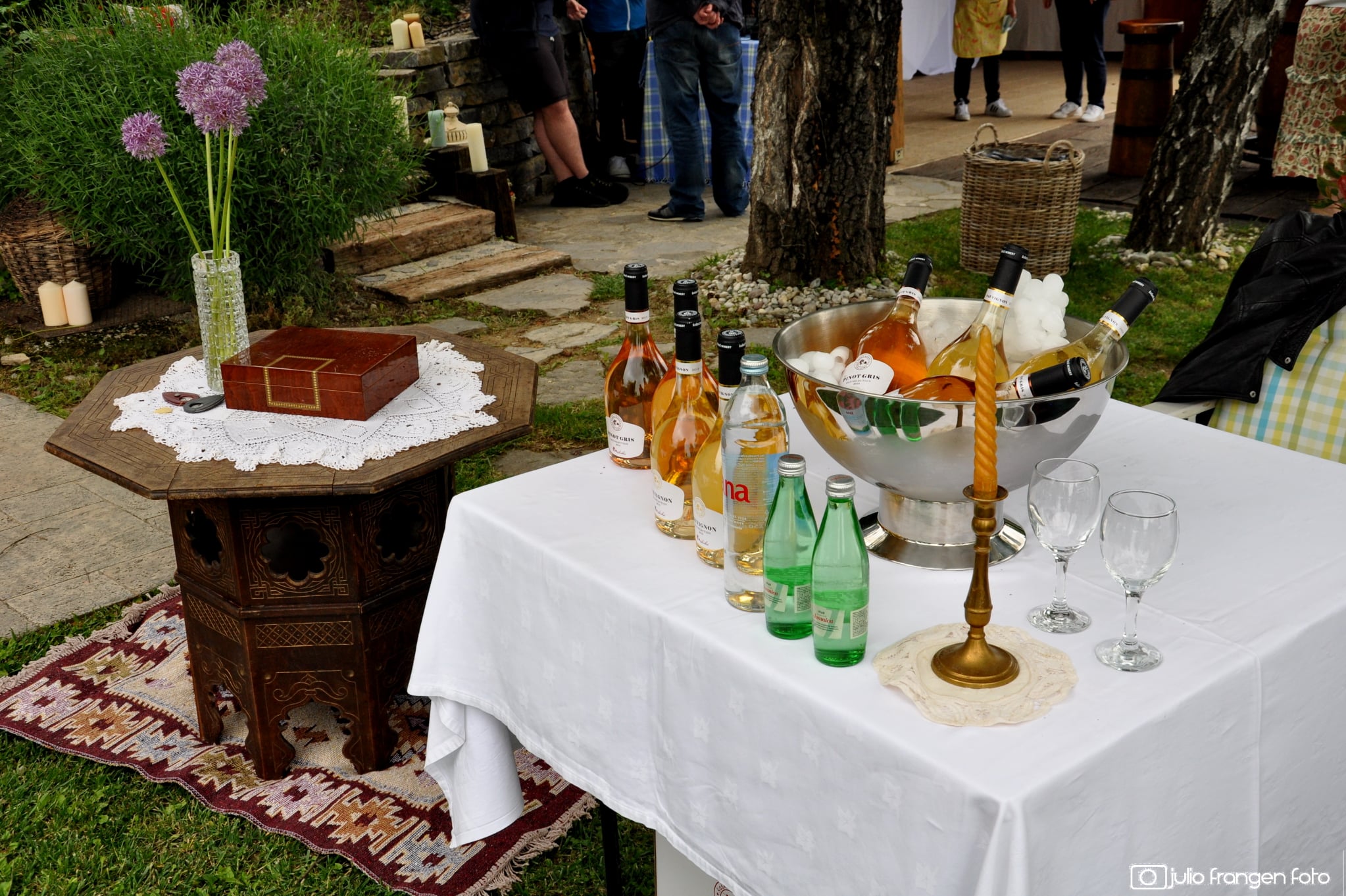
Salon of Sparkling Wines
The eye pleased, the palate celebrated, and the wines matched. The snacks were mesmerizing and the guests truly enjoyed themselves. An additional interesting and refined gathering was the presentation of a new wine from each winery, the so-called "An example of Plešivica". In this part of the program, Šember winery presented its new Chardonnay 2020, Šoškić wines, Sauvignon blanc 2020, Drago Damir Režek wines - Pinot Noir 2017, Šimanović wines presented Frankovka 2017. A special surprise of the day was Šoškić brandy, many did not know that such a pearl exists on Plešivica, it was sipped with gusto, gentlemen "spiced" it with cigars, and ladies with cigarillos. As an additional spice to the wonderful country atmosphere, similar to Provencal, served antique props from the Comedy Theater as well as tables and accessories from DVD Plešivica.
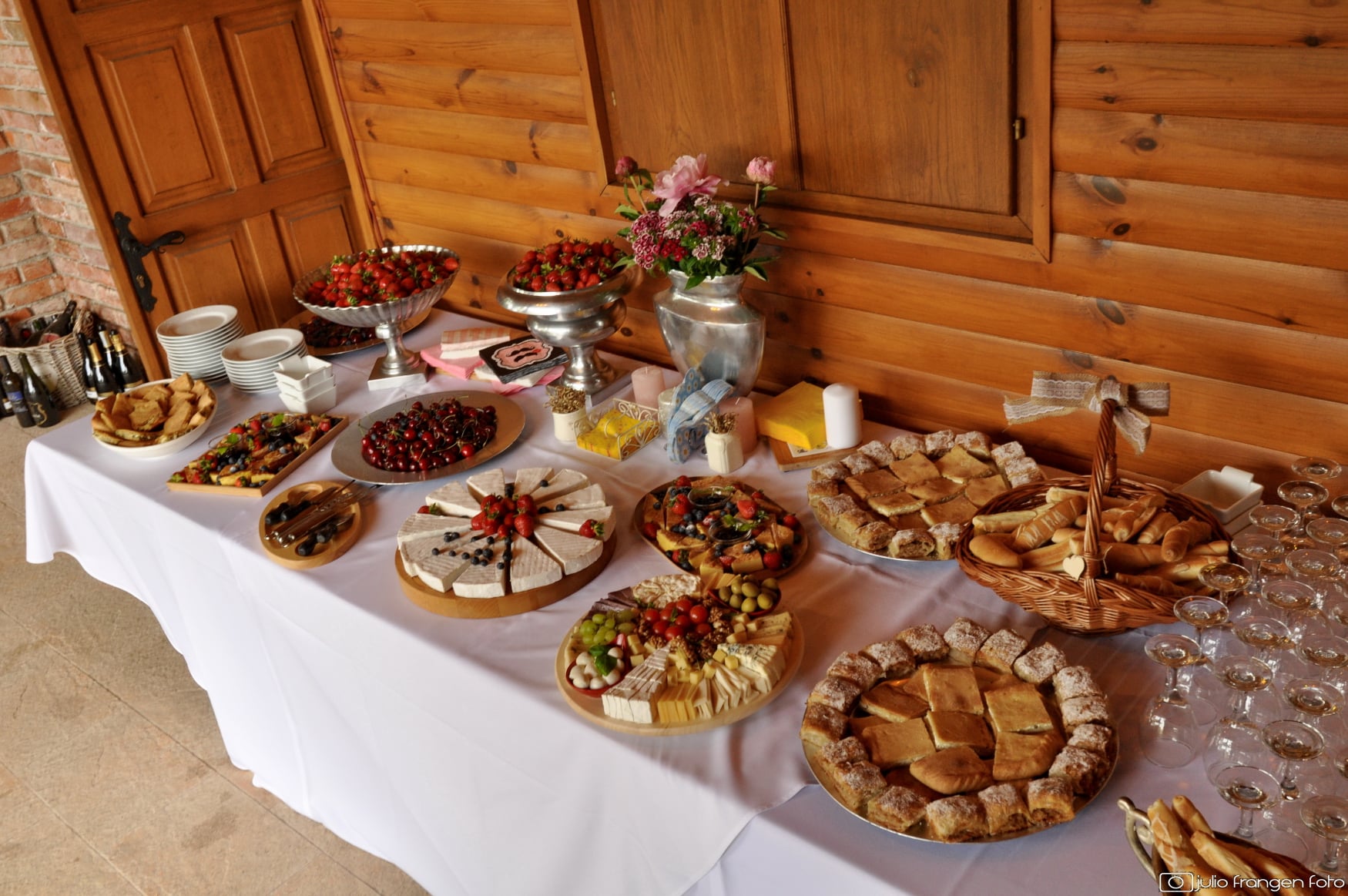
Salon of Sparkling Wines
Delighted guests, sparkling wine lovers, but also wine connoisseurs, sommelier, oenologists, wine merchants, in pleasant conversations with winemakers learned about Plešivica wines and selected snacks and the potential of various forms of tourist offer Plešivica in the context of branding wine destinations and entire vineyards through targeted, smaller events.
Croatian wines and grapes are among the best in the world, and you can find more information about them in Total Croatia’s Guide to Croatian Wine HERE. Total Croatia’s articles are now available in your language!
For all you need to know about Zagreb in 2021, make sure to bookmark Zagreb in a Page.
For more on lifestyle in Croatia, follow TCN's dedicated page.
Istrian Wine in International Spotlight Thanks to Croatia Unpacked
April 12, 2021 - Saša Muradori and Tanya Schmitt are the founders of Croatia Unpacked, with which they seek to popularize Croatian wine in Canada. Their company has been recently featured this month in an article in The Circular - the monthly publication by The Circle of Wine Writers - the world's leading international association of authors, writers, journalists, bloggers, broadcasters, photographers, and lecturers, communicating about wines and spirits.
Tanya was interviewed by award-winning wine writer & editor of The Circular, Amanda Barnes, about her interest in wine, her experience with Croatia Unpacked in the wine industry in Canada, and her passion for Istria. TCN transmits the full interview with Tanya:
What sparked your interest in wine?
I’ve always enjoyed wine, but it was when I met my husband – a self-confessed old-world wine snob – in 2005, that my interest was really sparked. Thanks to some wonderful trips (the only rule we have when we travel is to eat and drink local) and many enjoyable dinners, my palate swiftly evolved, and I quickly became a wine lover with, who would have guessed it, a preference for old-world wines…
It was, however, only when we discovered Croatian wine that I ever considered entering the wine industry. Croatia produces intriguing wines that, on tasting for the first time, were both familiar to us yet, at the same time, totally unique. Before I knew it, I found myself on a fascinating journey of discovery – exploring wine regions where indigenous grapes thrive, and where the influence of Croatia’s distinctive terroir is ever-present. Although I am no wine expert, I was quickly convinced that this was a wine experience that deserved attention.
You’ve been involved with Croatian wine and tourism since 2019. What attracted you to Croatia initially?
I am English, my husband Dutch, and outside of work, we are history & art lovers, explorers, foodies, and wine lovers. We live in Canada today, but holidays typically take us back to Europe, where we jump on a motorbike and hit the open road. Before heading out on a road trip a few years ago, a friend recommended that we visit Istria (northwest Croatia, a short hop from Trieste in Italy).
We took his advice and discovered a region so culturally rich yet relatively undiscovered, a gourmet paradise and a land of opportunity. During our short stay there, we visited one of the best-maintained roman amphitheaters in the Mediterranean, learned about the ancient technique of Amphora winemaking at a beautiful local winery, saw mosaics in Poreč that rival those in Ravenna, and were wowed by the food and wine scene. As entrepreneurs, we also saw incredible potential: gaps begging to be filled in the tourism sector, as well as opportunities to introduce the relatively unknown yet extremely high-quality local produce to the global stage, to name but a few.
You also co-founded ‘Experience Istria’. What do you think is the quintessential Istrian (tourism) experience?
Istria is a hidden gem. In recent years it has been labeled the “New Tuscany” – and with good reason. I often say to people that if you were parachuted into Istria, you could easily be mistaken for thinking you were in Italy, but a very rustic, natural version of its more developed neighbor. Tourists typically flock to Istria’s Adriatic coastline, with destinations such as “Venetian” Rovinj, being an eternal crowd-pleaser.
For me, however, it is time spent in the hinterland of Green Istria that reveals the true, authentic heart of the region. Picture a landscape of rolling hills, medieval hilltop towns, mysterious truffle-laden forests, and olive groves and vineyards stretching as far as the eye can see.
In October 2016, my husband and I visited Istria in the “off-season” for the first time. It was during this trip that we promised each other we would return at this time, every year. Autumn in Istria is difficult to beat. You will find yourself treated to the pungent aroma of generously shaved white truffles in the traditional konobas (local restaurants) scattered around the interior. Take a truffle hunt with a trusted guide and you may be lucky enough to find one yourself! It is also harvest time for both grapes and olives. As you roam the endless wine and olive oil roads, you will witness the locals coming out in their dozens to gather the precious fruits by hand, which will soon be lovingly transformed into the next great vintage, or in the case of olive oil, into liquid gold.
Unknown to many, Istria has been named the best olive oil-producing region in the world for the last 6 years, and an olive oil tasting experience is not to be missed. Istrians are proud of their cultural heritage and this can be witnessed in Autumn through a host of local festivals filling the cobbled marketplaces of hilltop towns. As an added bonus, with the summer crowds long gone, all that the region has to offer can be explored in relative isolation.
What really excites you about Croatian wine at the moment, and what do you think wine writers really ought to put on their radar?
I am excited about seeing Croatian wine increasingly recognized on the international stage. The tally of awards at the top competitions is growing year after year, and the global exposure to Croatian wine seems to be growing with it. This is a trend that I hope we will see continue.
The pandemic has, without doubt, been extremely challenging for the wine industry, as it has for many others. I do believe however that there has been one key learning out of it that will hopefully benefit Croatian winemakers in the long term. It is not easy to sample Croatian wine outside Croatia. Exports are notoriously low, with the output largely being consumed within the country by locals and tourists, with minimum quantities making their way to some fortunate countries throughout the EU.
With restaurants shut down, and tourism at all-time lows in the last 12 months, many winemakers have recognized the importance of diversifying their sales channels. This heralds an opportunity not only for the winemakers but also for inquisitive wine lovers, with previously unheard of varietals making their way onto wine shelves around the world. A few years ago, the intrepid explorer in search of sampling Grk, would have no option but to make the journey to the distant island Korčula, off the Dalmatian coast. To think that this wine will be available in Ontario (Canada) this summer is pretty exciting!
As for what I would like to see wine writers put on their radar, my answer would be Croatian wine! There is still relatively little coverage of the region, which historically may be tied to the low exports and thus lack of availability. However, as more and more wine agents, ourselves included, are bucking the trend and focusing on making Croatian wines available around the globe, it would be great to see wine writers embracing this evolution, and helping to educate consumers on this emerging new old-world wine destination.
Which Croatian wines are particularly resonating with the Canadian market? And what is the greatest challenge in selling Croatian wine to Canada?
The greatest challenge in selling Croatian wine in Canada is education. Croatia is not recognized by the average Canadian wine consumer as a wine-producing destination, let alone an old-world wine region. This is somewhat understandable, given that 12 to 18 months ago, you would have had to search high and low to find a single bottle of Croatian wine on a physical, or virtual, store shelf across Ontario – Canada’s largest province.
Changing this perception takes time – it will not happen overnight, but we are confident that it will happen. With the goal of shifting this perception, we spend significant time on promoting the brand of Croatia as a whole, rather than the brand of winery A or winery B. The wineries we partner with understand this challenge and have taken steps to form an association with this collective goal in mind. We are cautiously optimistic that, thanks to this association, we will secure EU funding in 2021 / 2022 for some pretty exciting promotional activities that will take place both in Canada and Croatia (as the situation allows). In the meantime, we are starting to see a shift emerging. As more wines are available on the market, inquisitive wine lovers are excited to try new varietals, are intrigued by the taste profiles, and, invariably, are surprised by the quality.
Wines with a great story are definitely resonating with the Canadian market. For example, the majority of Canadian wine lovers may not be familiar with Plavac Mali, but they most definitely know Zinfandel. Plavac Mali is the renowned offspring of 2 ancient Croatian varietals, one of which – Tribidrag – is in fact the original Zinfandel. Telling this story draws an immediate connection in the mind of the consumer with something known and trusted, and it has definitely opened the door to a new and growing following for Dalmatia’s flagship red. Followers now start to embrace Plavac Mali and compare it to a Californian Zinfandel, in the same way, others compare a Burgundy to a Californian Pinot Noir.
We have, most recently, had incredible success with Dalmatian Dog Babić from Testament Winery. Babić is a lesser-known varietal, comparable to the much loved Italian Chianti. It is the price to quality ratio of this wine, outshining similar wines from its Adriatic neighbor, that has contributed to its success, with its latest release in Ontario selling out in less than a week. This will not be a one-off. There are many other success stories like this just waiting to be told!
Finally, do you have any exciting travel plans post-pandemic? What’s next on your bucket list?
Like so many, I am longing to travel again, once it is safe to do so. Priority number one will be spending some time with my close family in England. After this, we will definitely be heading back to Istria, hopefully just in time for white truffle season!
In a few year's time, we are looking forward to calling Istria home. In addition to the pleasure that we know this will bring us in our daily lives, its central location, in the heart of Europe, also opens up easy access to a range of new bucket-list targets. First on our list will definitely be riding on our motorbike into Istanbul!
If you are interested to get a taste of Istria from the comfort of your home, then please join Tanya, and her co-host Wanda Srdoc, on April 24th at 6 pm for "An Evening to Experience Istria" - a gourmet escape to Istria with wine and truffles!
To read the original article by The Circular, click here.
To know more about wine in Croatia, read our Total Croatia dedicated page.
To read more about lifestyle in Croatia, follow TCN's dedicated page.
Long-Awaited Vivodina Wine and Walk in Karlovac County Has Been Announced!
April 7, 2021 - Wine lovers and all nature lovers will be able to delight their palates and enjoy the beautiful Vivodina slopes in the Žumberak - Samoborsko Gorje Nature Park, all while respecting epidemiological measures, during the Vivodina Wine and Walk event!
Tourist and recreational event Vivodina Wine and Walk will be held for the first time in Karlovac County. It is a great opportunity to get to know the wine-growing region and local eco gastronomy. Participants can expect a large selection of quality and top wines and enjoy the picturesque landscape of the nature park.
Turistickeprice.hr reports participants of this year's event will have the opportunity to visit eight wineries through a six-hour walk during which they will be able to enjoy all the delicacies of the Vivodina region. At each of the points, the host will be welcomed and will be able to taste the best wines and discover the secrets of Vivodina wine from the owners of wine cellars. The organizers announced that they will welcome the participants at certain points with additional surprises, especially for those who are coming to Vivodina for the first time.
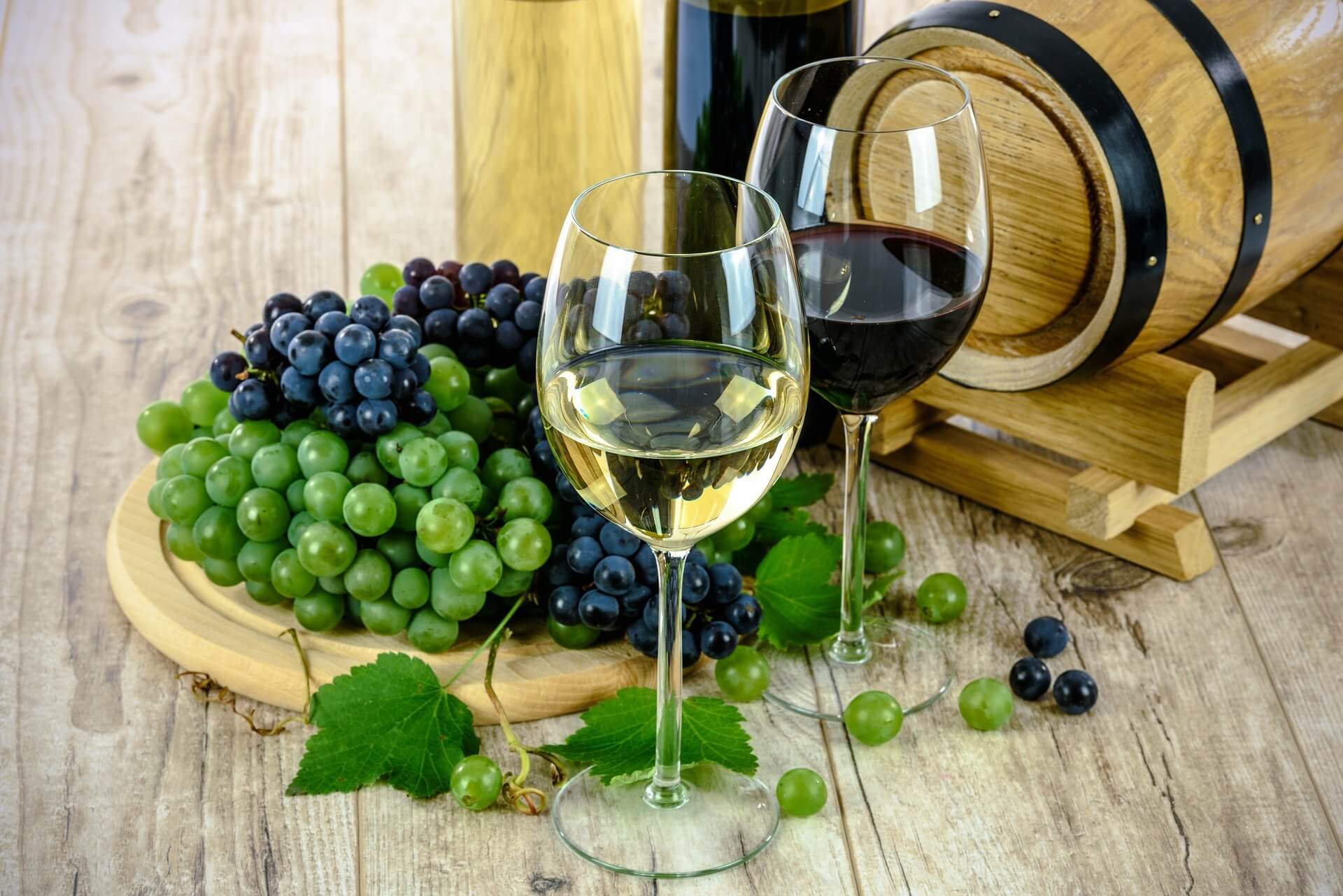
Pixabay
The beginning of the walk starts from the wine cellar of Josip Vrbanek along the river Kupa which goes uphill to the center of Vivodina. In contrast, the second half of the walk is light intensity and completely downhill. The complete route passes right next to the vineyards and beautiful places of the Vivodina region, located within the Žumberak - Samoborsko Gorje Nature Park. It follows the section on which the World Rally Championship will take place a week later.
Starter packs include a personalized glass, a start number for free wine consumption, a ticket with marked refreshment stations, vouchers for lunch and refreshments at various wine stations, a bottle of water, and a guided tour by expert guides.
"We invite all those interested in securing their place for unforgettable socializing, either with family or their friends," said the Tourist Board of Karlovac County. If you are coming by highway, the easiest way is to get off the highway in Karlovac and follow the direction of Ozalj. After the old town of Ozalj, the main road leads along the river Kupa, which is located on the right. The beginning of the wine and walk trail is located immediately after crossing the bridge and turning for Vivodina on the right side, where it is also the first stop of this adventure.
After a pleasant time in Vivodina, do not forget to visit other attractions in Karlovac County. You can find more information in the online guide.
The organizers of this event are AK Marathon 2000, Association of Winegrowers, Winemakers, and Fruit Growers Ozalj with the support of destination partners of the Regional Tourist Board of Karlovac County, the Tourist Board of the Cup area, and the Žumberak - Samoborsko Gorje Nature Park.
For more about lifestyle and events in Croatia, follow TCN's dedicated page.
Kvarner Wines in Spotlight: Two "Sparkling Kvarner” Workshops held in Zagreb
March 22, 2021 - Hotel Dubrovnik announced the 5th Salon of Sparkling Wines with two sparkling Kvarner workshops on Friday, March 19.
Fiuman reports that two sparkling wine workshops were held in front of loyal visitors: Sparkling Kvarner and Natural Sparkling (Croatia & Slovenia).
At the first workshop, six wines produced by the pét-nat method (fr. pétillant naturel) were presented at a "blind" tasting. With the leader dr. Sc. Nina Levičnik, the founder of the Salon of Sparkling Wines network and a big fan of "natural" sparkling wines, the participants learned what the terms pét-nat, méthode ancestrale, and col fondo have in common and how they differ from other methods.
The presenter emphasized the importance of "terroir" in wine production with this ancestral method. The Croatian representatives were Tomac, Šember, Veralda, and the Slovenian Atimo, Keltis, and Štemberger.
At the second workshop, participants learned that Kvarner is the third Croatian wine region in terms of sparkling wine production. The recently founded the Kvarner Wine Association which today has as many as 10 sparkling wine producers who were presented at the workshop under the auspices of the Kvarner Tourist Board. Sparkling wines in Kvarner are produced from the original varieties - žlahtina, belica, mast - charmat, and the traditional method.
The moderator, Dr. sc. Žarko Stilin, secretary of the Kvarner Wine Association, one of the loudest promoters of original Kvarner wine varieties, organizer of several wine events, the most important of which is the International Wine and Gastronomic Festival WineRi, spoke about the interesting and special features of Kvarner sparkling wines.
Participants tasted 10 sparkling wines: Maličić winery Šipun, Porin Estate Winery Katunar, Valomet PZ Vrbnik, Gospoja PZ Gospoja, San Marino Wine houses Pavlomir, Soubze catering and Nada shop, Stara Bakarska Vodica PZ Dolčina Praputnjak, Biser žlahtine Ivan Katunar - Plovanić vina and Ružić - OPG Ružić.
Workshop leader dr. sc. Žarko Stilin proudly stated that sparkling wines in Kvarner have a long tradition, and with the Kvarner Wine Association, the promotion will be even more visible through many activities, education on table culture, organization of round tables, lectures, and scientific conferences to promote Kvarner with the support of Kvarner Tourist Board.
The wine workshops were an introduction to other sparkling events ahead of the 5th Salon of Sparkling Wine Zagreb, on June 11, 2021, on the Oleander terrace of the Hotel Esplanade. The date has been targeted to meet the summer and the upcoming tourist season when the consumption of sparkling wines will be more frequent than usual and any promotion is welcome.
For more about lifestyle in Croatia, follow TCN's dedicated page.
Ludbreg Winemakers' Wines Thrive Due to God-Given Microclimate
January 23, 2021 – The feast of St Vincent's Day, Vincekovo, could not be celebrated this year due to the epidemiological situation, but Ludbreg winemakers continue to focus on their wine production. Thanks to the very favorable climate, the Ludbreg area is suitable for planting vineyards, and local winemakers hope to soon get their well-deserved place on the Croatia's wine list.
Vincekovo, which was celebrated yesterday, January 22, in the Ludbreg area, used to be celebrated in Globočec when the plantations were blessed. The main event was a traditional and unique exhibition of young wines from the Ludbreg and surrounding vineyards, which was canceled this year due to strict epidemiological measures and a challenging situation.
It is an additional blow for all caterers who suffered the most in the corona crisis and wine producers. Local winemakers and winegrowers will wait for some better times to meet and rejoice with friends.
Sanja and Tomislav Stručić, top winemakers from Ludbreg, who met with TCN in Ludbreg last year, told their business story for the Epodravina.hr portal.
Family vineyard three kilometers from the center of the world
"We were pleased by the announcement that we could reopen our doors in February, but if we won't open until Easter, as announced, the season is questionable. We are very affected," says winemaker Sanja Stručić.
However, despite the pandemic, wine lovers are not resting. Caring for the vineyards is a year-round work, essential for producing good wine. The season begins now when the first pruning is done and lasts until the harvest.
"Last year, we estimated that, given the situation with the coronavirus, we would have stocks of wine. Therefore, we reduced the grape yield during pruning in the spring. We left grapes for sparkling wine and wines to age. We want to produce quality, not quantity, that is, high-quality wines," says the Stručić family.
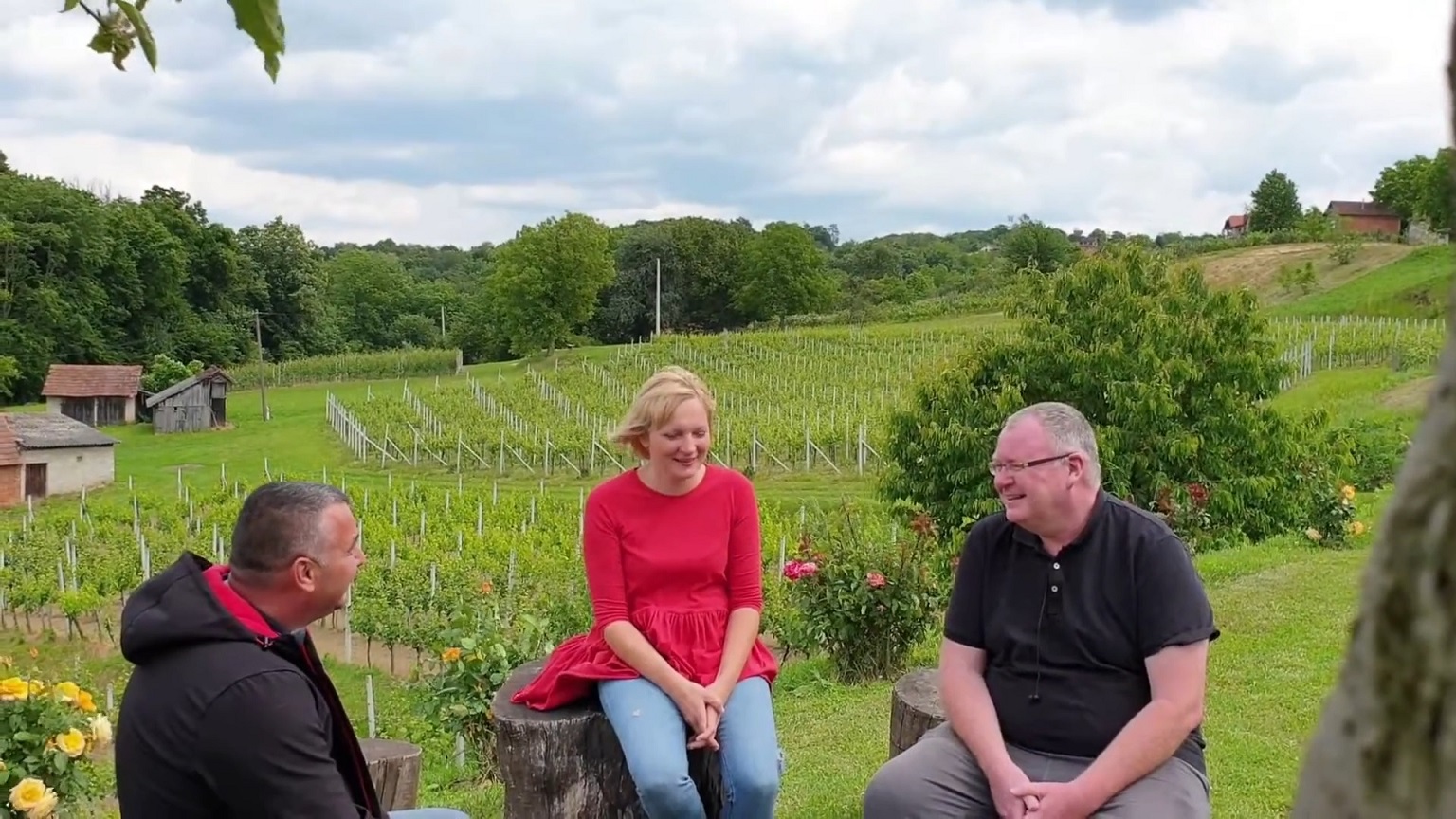
Sanja and Tomislav Stručić with Paul Bradbury in 2020, Total Croatia News
Their beautiful wine-growing hills, clean air, excellent wine, and hospitality evoke the love of land and viticulture that began in 1984 with a family vineyard just three kilometers from the center of the world. Sanja's father, Dragutin Crnković, once planted the first vineyard there, passed on his love of viticulture to his daughter, and introduced her to the wine business.
Emphasis is on the premium line of nature wines
Sanja's husband, Tomislav, also fell in love with winemaking and viticulture. In 2000 they founded the Winery, and in 2017 they produced the first sparkling wine in the region. They are the new wine style leaders in Varaždin County, and today they create top and quality wines.
Stručić Winery has become one of the most famous and successful and began more severe production in 2002. The emphasis is on the premium line of wines represented by nature wines. The premium line consists of carefully selected bunches hand-picked from selected vines. Sanja showed her love, passion, and care for each of these grapes before they become wine.
"Only ripe grapes are picked from the petiole by hand, clean and healthy. Fermentation on own yeasts and grapes, without the addition of selected yeasts, produces natural wines. This top line comes in different bottles and has different labels. We have been making it in small batches, approximately 750 bottles, for four years now, every year with a new vintage," says Sanja.
Back in 2016, Stručić family even produced a special edition of Sara Kolak Chardonnay to celebrate the local Olympic javelin gold-medal winner.
Journalists who encourage stories about gastronomy, tourism, and hedonism are also responsible for the turn in wine production. The Stručić family decided to take advantage of the microclimate and their plantations' position, which enable them to produce excellent raw materials for the production of different wine styles.
"We researched and realized that our region is a microclimatic God-given. While visiting various wine fairs and festivals, we realized we want to make different wines. The exhibitions were an incentive for us to expand our knowledge to be as good as possible. We also visited wineries in Italy to get a better insight into their viticulture and winemaking that is at a high level, and to apply experiences and some wine secrets in our vineyard and cellar," says Sanja on how they started producing sparkling wine and natural wine.
Produced the first sparkling wine in the region
The family vineyard initially had 3,500 vines and was later expanded with new plantations. Today, they cultivate three and a half hectares of land with 14,000 vines. It consists of plots named after the youngest members: Lucija, Luka, and Petra, and the newest plantation was named after their niece Katarina. The plots are registered by varieties and years of planting. The rulers of their vineyard are Graševina, Chardonnay, Rhine Riesling, Sauvignon, Portuguese and Yellow Muscat.
"We produce Graševina, Chardonnay, Sauvignon, Rhine Riesling, and mixed wines. Poštenjak is a blend – a mixture of Graševina, Chardonnay, and Pinot Gris. We make fruit wines and liqueurs, and sparkling wine. We produce about 25,000 bottles a year," says Tomislav.
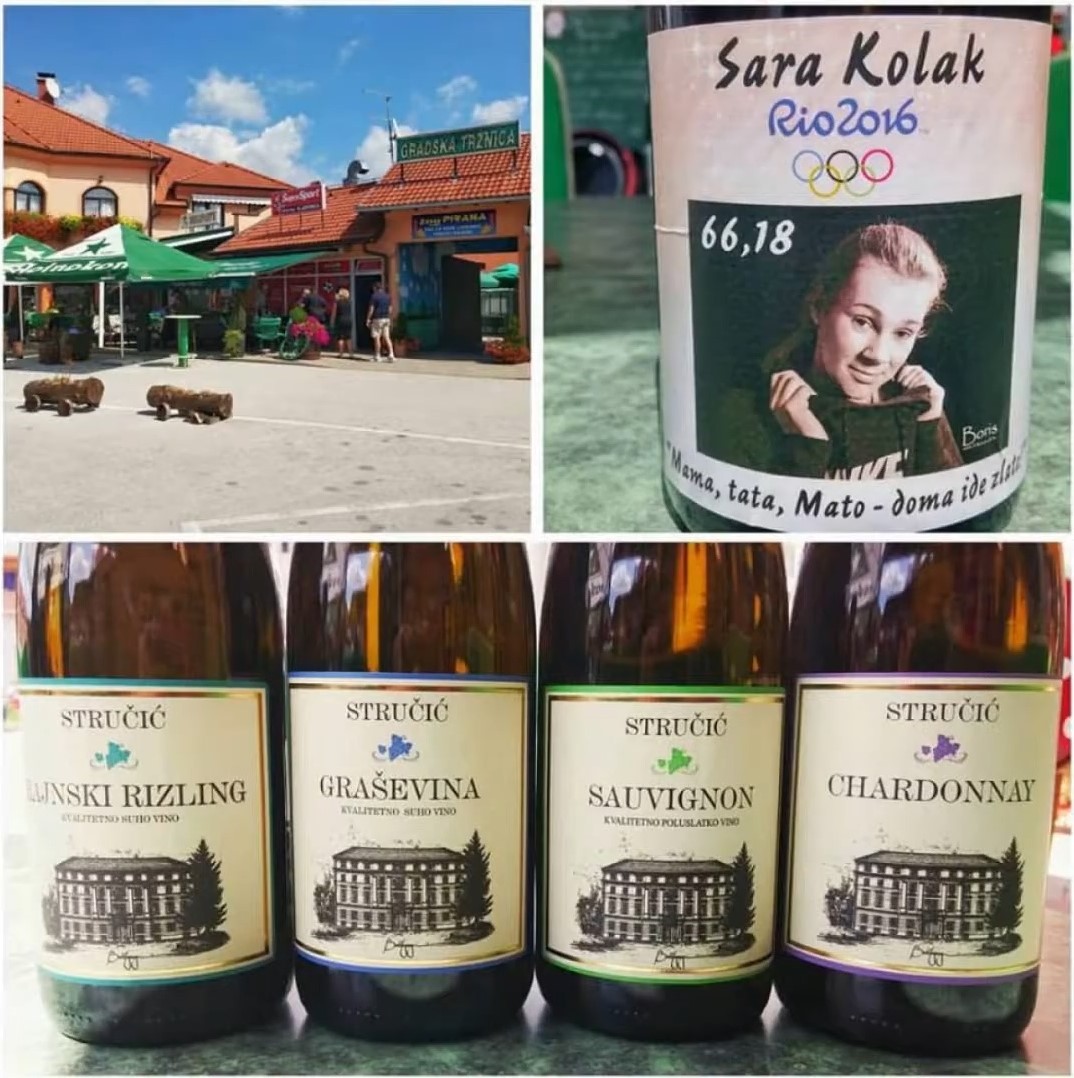
The opening of the Ludbreg Wine Road about ten years ago encouraged a stronger development of their winery. Thus, in 2017, Vinarija Stručić produced the first sparkling wine from the Ludbreg vineyards, which has the label "blanc de blancs" (namely "white from white"), which means that only white grapes were used in its production, that is, Chardonnay.
"After top quality wines, every winemaker wants to produce sparkling wine. It is the crown of your work, as if, for example, you have won the World Cup. The production of sparkling wine was our desire for a step higher. And now, three years ago, we are doing batch after batch," Sanja points out.
The Croatian Wine Institute, which evaluates and issues a quality certificate, rated their sparkling wine as top quality. And there is only five percent of top wines in Croatia, so they expanded their production in 2018 with rose sparkling wine from the Portuguese. It is a unique rarity in Croatia, produced by only one other winemaker on Plješivica.
Microclimatic conditions with a continental climate favor the quality ripening of grapes, so the Podravina and Zagorje regions are God-given for sparkling wine production. The Ludbreg vineyards' climate is ideal for producing light wines with little alcohol, sparkling wine, and wines of late harvests.
Decanter quality certification
Stručić Winery sells its products throughout Croatia. In Ludbreg, visitors can taste their wines in the Bonaparte coffee bar, which they own, as well as the Amalia catering facilities, Pivnica Mejaši, and Hotel Crnković.

"Rhine Riesling is mostly associated with the name of our winery. It is our flagship and our most sought after wine on the market. Then follow Graševina, Chardonnay, Portuguese, Sauvignon… Premium wine lines, sparkling wines, aged, and nature wines are distributed to the Adriatic coast," says Tomislav.
The secret behind the Sučić Winerys's success, Sanja points out, is harmony, great love, patience, a lot of sacrifices, and constant investments. Proof of quality arrived last August when the Stručić Winery won a bronze medal for Chardonnay and recommendations for Rhine Riesling and Graševina at the most influential wine evaluation – the Decanter World Wine Awards 2020 in London.
"It is a confirmation that we make quality wine. With these recognitions, we have increased visibility," says Tomislav with satisfaction.
Ludbreg vineyards on the wine list of Croatia
For wines to achieve top results, a lot of education, work, and knowledge is needed, so the Stručić family cooperates with the leading Croatian sommelier and Decanter judge Siniša Lasan. With Varaždin County's cooperation, Siniša visited several wineries and tasted wines, discussed problems, and gave his view of the current situation in winemaking in the county.

Continental tourism is in the beginning. Tourism Ministry began to give it importance and encourage it only a few years ago.
"The Ludbreg and Varaždin vineyards are neglected. They are not marked on Croatia's wine list, and our winemakers are very hardworking but self-effacing. A dozen of us from all over the county will have to sit down, compare wines, listen to the profession to style them if necessary so that we stand out together with quality. I believe that we will soon mark our vineyards on the wine list, which would raise the price, and we could sell our wines more easily on the doorstep," Sanja is optimistic.
"Viticulture is a demanding activity that requires a lot of attention because wine is alive and should be continuously monitored. Without love for the vineyard and wine, there is no progress, "the Stručić couple agrees.
However, the biggest reward in their work is that the interest in winemaking is shown by their 17-year-old son Luka. He wants to enroll at the Faculty of Agriculture and become a wine expert, oenologist. Thus, when the time comes, to the family's satisfaction, the winery will be taken over by the third generation, which will cultivate, enrich, and further create new top-notch wines.
To read more about Ludbreg, follow our dedicated page.
In Cultura Veritas: Successful International Cooperation of 40 Winemakers
December 6, 2020 – With the project In Cultura Veritas, 200 kilometers of wine roads and 80 cultural heritage sites were connected in the cross-border area between Zagreb County in Croatia and the Obsotelje and Kozjansko subregions in Slovenia.
As Lokalni.hr reports, the main goal of this recently completed project, which lasted 28 months and is worth one million euros, was to contribute to the attractiveness, attendance, and protection of the cultural heritage of the area and increase economic activity through the development of a new sustainable cross-border destination. The goals were also to strengthen the capacity of local stakeholders and the comprehensive promotion of tourist destinations from the Zagreb County and the Slovenian subregions Obsotelje and Kozjansko.
The In Cultura Veritas project was implemented by Zagreb County, with partners the Museum Documentation Center and the Association of Croatian Travel Agencies. Slovenian partners were the Sotla Development Agency, the Municipality of Šmarje pri Jelšah, and the Maribor Agricultural and Forestry Institute.
On behalf of Zagreb County, the project was presented by Ivana Rendulić Jelušić, who pointed out that thanks to this project, the attractiveness of the offer of cultural and wine tourism in Zagreb County was increased following the requirements of modern visitors.
The cooperation of about 40 winemakers from the area of Zelinska, Samoborska, and Plešivička wine roads, the towns of Samobor, Jastrebarsko, and Sveti Ivan Zelina, and their city museums have borne fruit.
As Večernji.hr reports, the attractions of wine and cultural tourism within the new destination have been promoted by the application of modern digital tools, the improvement of the visitor infrastructure, and the renewal of cultural heritage.
This project idea was developed thanks to the recognition of common and insufficiently promoted tourism potentials in the cross-border project area. The area has a rich and somewhat forgotten cultural and historical heritage preserved in about 80 cultural heritage sites located along 200 km of wine roads.
The centuries-old tradition of wine production is an important part of life in this area, and the quality of the wine is confirmed by numerous awards that adorn the walls of wineries on Plešivica, Zelina, Samobor (Croatia), and Šmarje-Virštanj wine roads (Slovenia). It is in this area that the oldest vine in the world is located, the one from Maribor. Also, the fluttering and fresh white wine Kraljevina, which is believed to have been drunk by the famous Beethoven, is an autochthonous variety produced only in the Zelina area in Croatia.
Zagreb County was the leading partner of this project and thus digitized the tourist offer of the new cross-border tourist destination. A digital catalog with the cultural and wine offer of this area is available on the project website, where you can find information about winemakers, museums, natural heritage sites, photographs, multimedia content, and interesting facts and legends about famous people associated with the project area.
The digital catalog is also available on a mobile application, as well as on tourist machines and smart benches set up by the Zagreb County in the center of the cities involved in the project – Sveti Ivan Zelina, Jastrebarsko, and Samobor.
To read more about lifestyle in Croatia, follow TCN's dedicated page.


